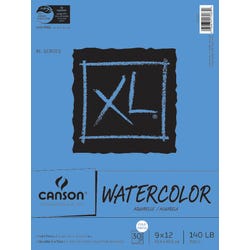Color Field Representational Landscapes

Description
Lesson Plan and Artwork by Phyllis M. Annett
Students will create a landscape with colored pencils in a Color Field technique on a square format.
Objectives
- Students will realize that landscapes are a record of history and that Art and History go hand in hand for they tell the story of man through the centuries.
- Students will experience the use of colored pencils by creating a landscape grounded in reality, rather than abstraction using a Color Field, color-layering technique.
- Students will experience and understand the techniques of colored pencil application.
- Students will use the Principles of Art and Design as their guide.
Supplies Needed
General Pencil Woodless Coloring Pencils (Plasti Pastels)
General’s Drawing Class Essential Tools Kit
Canson XL Watercolor Pads, 30 sheets
*Here are the supplies needed for this lesson plan for reference. Find a convenient carousel of shoppable products for this lesson below.
Standards
Standard #2: Organize and develop artistic ideas and work
Standard #3: Refine and complete artistic work.
Standard #5: Develop and refine artistic work for presentation.
Standard #9: Apply criteria to evaluate artistic work.
Standard #10: Synthesize and relate knowledge and personal experiences to make art.
Standard #11: Relate artistic ideas and works with societal, cultural and historical context to deepen understanding.
Instructions
1
Inform students that they will create a landscape with colored pencils in square format using a color field, color layering technique. The landscape will be representational, bordering on abstraction but stay grounded in reality. The pencils come in ten beautiful colors which lend themselves well to a layering technique resulting in colors within colors. Students can also achieve various effects using the side as well as the point of the pencils. The end result is an exquisite soft effect. For the actual project, students will color on 11” x 11” watercolor paper for its weight and texture.
2
Research artists that have used a color field method to create layers of color within blocks of color. Stress that they should not get lost in details for a landscape , but have it rather border on abstraction and grounded in reality. Artists know for Color Field Work are: Mark Rothko, Barnett Newman, Clifford Still, Robert Motherwell, Hans Hoffman, Wolf Kahn. Stress the fact that students are not just putting bands of color down, but achieving depth, perspective dimension and vibration by using colored pencil techniques as follows: Strokes: long and short strokes of color achieve texture and coverage. They can be curved, straight, angular, or jagged. Hatching: elongated strokes of varying lengths that can be spaced for either density or openness. Cross Hatching: forms patterns that can be interwoven or overlaid with color to create a richness and create other colors. Gradation: Lay down color in different degrees of pressure to create sculpted forms. Tonal Layering: applying an even layer of color so that you can apply another layer of a different color over it to achieve new colors. Graduated Tonal Layering: achieved by putting pressure in your line from heavy to light and then light to heavy. The result is the impression of dimension. Demonstrate the techniques as the student follow along using the coloring pencils. Show the students how to use an eraser for blending as well as erasing. Also, have students use sketching pencils to practice pencil techniques using just graphite as the color to emphasize the power of the various strokes to achieve different techniques.
3
Remind students of the Principles of Art and Design and how they should be incorporated into their work. Share examples of good compositions for landscapes and challenge them with an 11” square format.
4
Have students do a sketch of a landscape using drawing pencils on square paper. This will help students to formulate the layout for the parts of the landscape and formulate a well-balanced composition. Next, give the students use of the colored pencils and the watercolor paper. Have them use the pencils on their sides to lay down large bands of color onto 11” x 11” square drawing paper to represent parts of the landscape. Next students will use the colored pencil techniques to build areas of color with depth and degrees of color. Students will continue to build color in each big color field until desired effects are achieved to create a landscape of rich color and depth. Inform students that the colors are soft and give a soft effect to the landscape, thus adding atmosphere.
5
The result will be a color-blocked representation of a landscape with rich color and depth.
6
Decide on evaluation criteria and mat the artwork.




